History of the mackerel
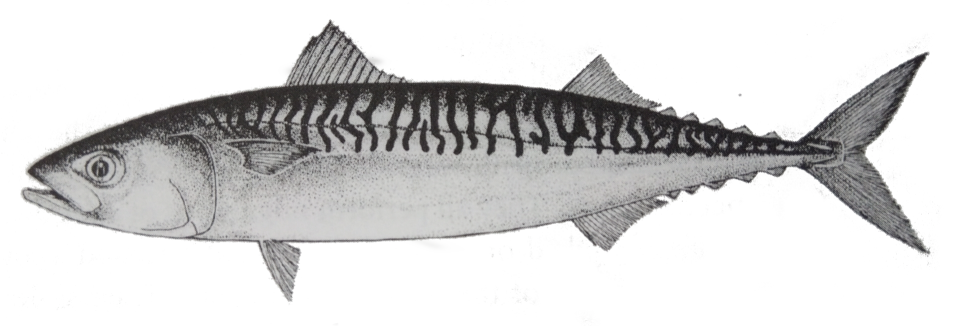 Did you know that in the seventeenth century mackerel was the only fish allowed to be sold openly on Sundays? Even the Archbishop of Canterbury in England realised that if a good mackerel wasn’t shown a cooking pot quickly it would spoil beyond repair. It is true that S. scumbrus spoils rather quickly due to its high contents of histidine as explained on the recipe page.
Did you know that in the seventeenth century mackerel was the only fish allowed to be sold openly on Sundays? Even the Archbishop of Canterbury in England realised that if a good mackerel wasn’t shown a cooking pot quickly it would spoil beyond repair. It is true that S. scumbrus spoils rather quickly due to its high contents of histidine as explained on the recipe page.
The French name ‘maquereau’ also means ‘pimp’ which most people associate with the mackerel’s brilliance of colours. There is, however, also a more entertaining explanation: As soon as Spring comes, the maquereau follows the young shad (marine fish related to herring that spawn in rivers), that are commonly called virgins, and brings them to their males and so they make a bawd of this fish. Unfortunately, this very precise and logical explanation doesn’t seem to be true.
What’s certainly true is that mackerel has been and still is Ireland’s most important wild-caught species and has supported many Irish livelihoods for centuries.
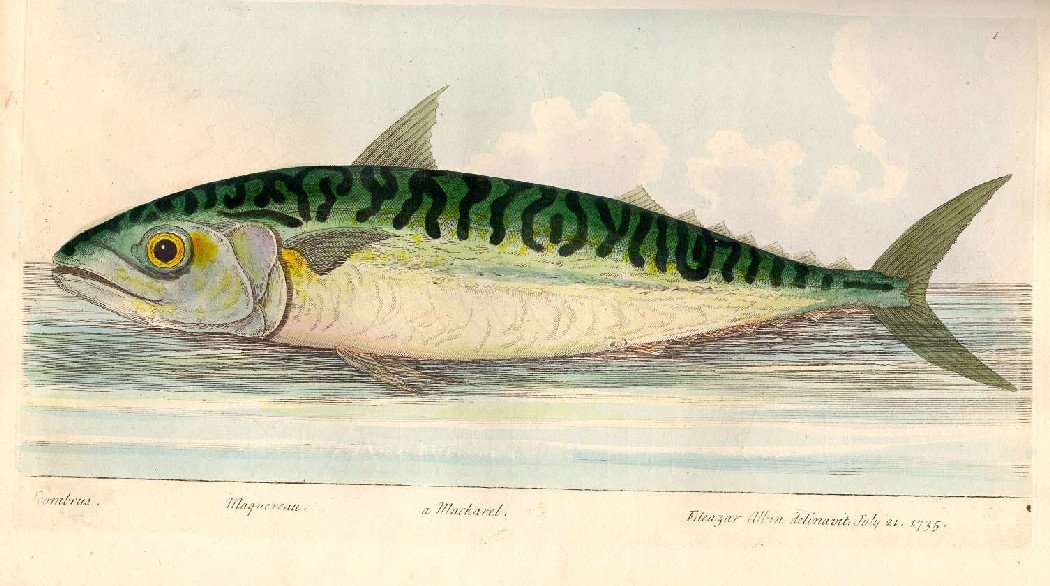
There is an Irish saying that it is worth throwing out a sprat to catch a mackerel “scadán beag a úsáid le scadán mór a cheapadh”
Indeed, this iridescent beauty brought Baltimore in Co. Cork to great wealth when the village became the leading centre of the mackerel industry towards the end of the 19th century and the accompanying prosperity – after more than two centuries of social obscurity and economic stagnation when its pilchard fishery ceased around 1750. According to Fitzgerald (1999), Baltimore’s importance as a landing place for mackerel was primarily dependent on non-local fishermen with superior catching power. English fish buyers dominated the marketing and distribution of fresh mackerel to England and cured mackerel to America in the absence of a viable home market. However, the arrival in 1879 of Fr. Davis in Baltimore as parish priest and his collaboration with English philanthropist Baroness Burdett-Coutts, enabled Baltimore to capitalize on the new opportunities afforded by fortuitous changes in the mackerel industry. Despite the short-term nature of the economic success of Baltimore as a centre of the mackerel fishery, this industry created a cosmopolitan blend of people and saw the development of its marine infrastructure and onshore services yet again. McGillicuddy (2008) informs us that salt-cured mackerel was a key export product in late 19th and early 20th century southwest Ireland, in the production of which women played a fundamental role.
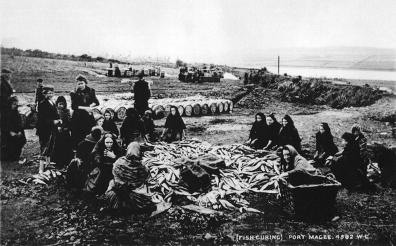
From a ‘Report of the Inspectors of Irish Fisheries on the Mackerel Fishing in Ireland during the Spring of 1890’ written Thom & Co. Ltd. (1890), we can identify that the mackerel fishing in spring was mainly carried out off the south and southwest coast of Ireland. Nearly all the fish taken in spring was exported fresh packed in ice in boxes while the autumn caught fish was salted in barrels for the American market. While big boats used large drift nets, small boats used drift and seine nets. Nowadays mackerel are mainly caught by midwater trawls.
The report gives a total of 207,806 boxes of mackerel landed for the spring of 1890 which equated to £182,024 at the time. The below table gives more detail on each station and price.
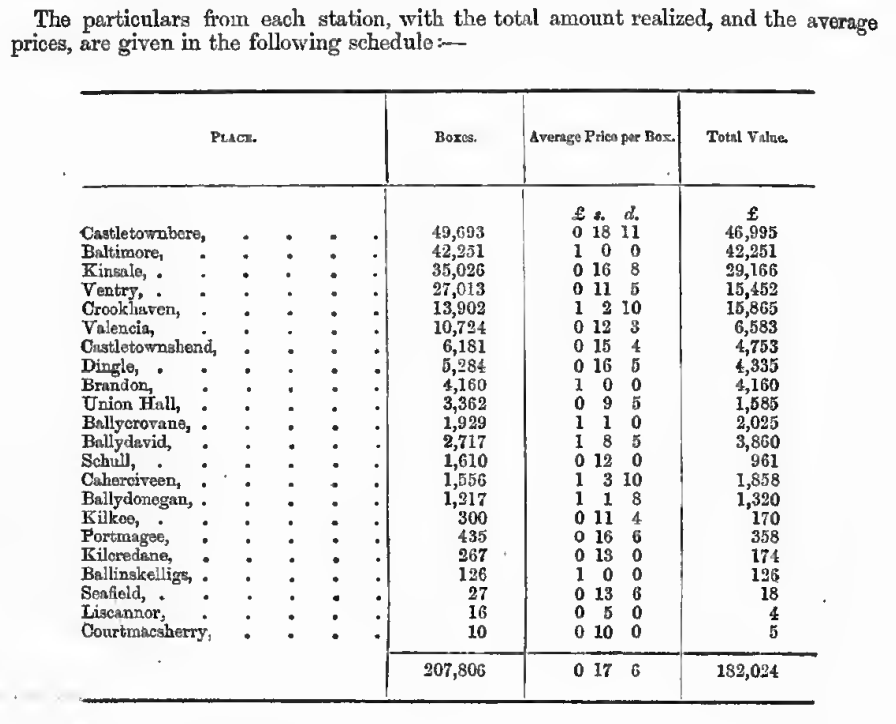
It is interesting to read about two apparent stocks, the spring and the autumn stock. In fact, the Atlantic mackerel was first officially described in 1758 by Swedish zoologist Carl Linnaeus in his 10th edition of Systema Naturae. Linnaeus gave it the scientific name Scomber scomber from the Greek word skombros meaning "tunny" or "mackerel". Because of its wide distribution, the Atlantic mackerel was independently described six more times by five different scientists between 1814 and 1863. Its specific name was later changed to scombrus by Collette and Nauen in 1983.
The National Folklore Collection, UCD Dúchas.ie also provides great evidence of mackerel fishing along the Irish south and southwest coast (© The Schools’ Collection, vol. 0924, p.24-25 by Michael Mullett, Arklow, Co. Wickow): “The large boats were all great sailing boats, the old fishermen handled them with wonderful power. In those large boats, the men went from fishing port to fishing port all round the Irish coasts and also to the Scotch Coasts.
They fished according to the season of the year for the herrings or mackerel. The mackerel fishing boats place usually in Cork or Kerry at such places as Kinsale, Scibbereen, Beerhaven, Valentia and Dingle and other places on these coasts.
It took place in Spring and about 60 large boats left Arklow usually on St. Patricks Day for one of the above named places. […]
Each boat had a 'train' of mackerel nets which consisted of 45 to 55 or 65 nets fathoms long and 5 score (100 misches deep). These were drift nets - and were hawled and set by hand.”
The mackerel even featured in weather forecasts, though this only addresses the wavy pattern on its upper back body rather than the fish itself. Another beautiful treasure from the Dúchas Schools’ Collection, vol. 0792, p.95 by Joseph Connolly from the Boys school in Howth
Signs of the weather
- Here is a list of the signs of bad weather seen in Nature.
- When Howth Head puts on its cap,
- Let all Fingal beware of that.
- When soot falls down the chimney, put up your umbrella.
- When the turkeys-gobble gobble,
- Water in the well will bubble.
- If the "Eye" sticks its nose into Howth,
- Rain will drive home the goat.
- If seagulls rest on inland lea,
- Rain and wind expect at sea.
- If there's a whistle in the breeze,
- Sow westers, sow westers if you please?
- A wind dog in the sky,
- Changeable weather nigh.
- If a mackerel sky shows any day,
- Windy weather comes to stay.
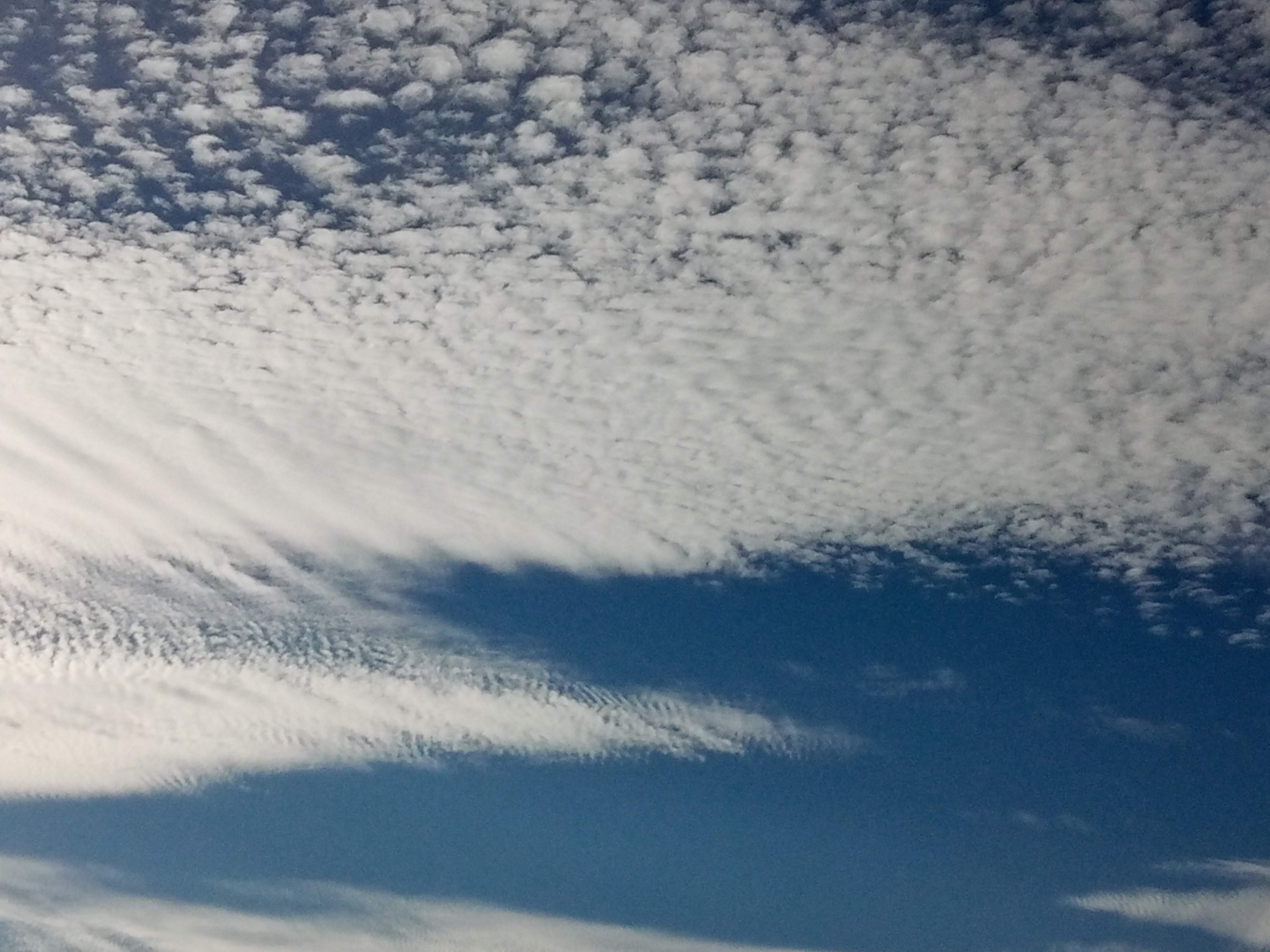
Ecology of mackerel
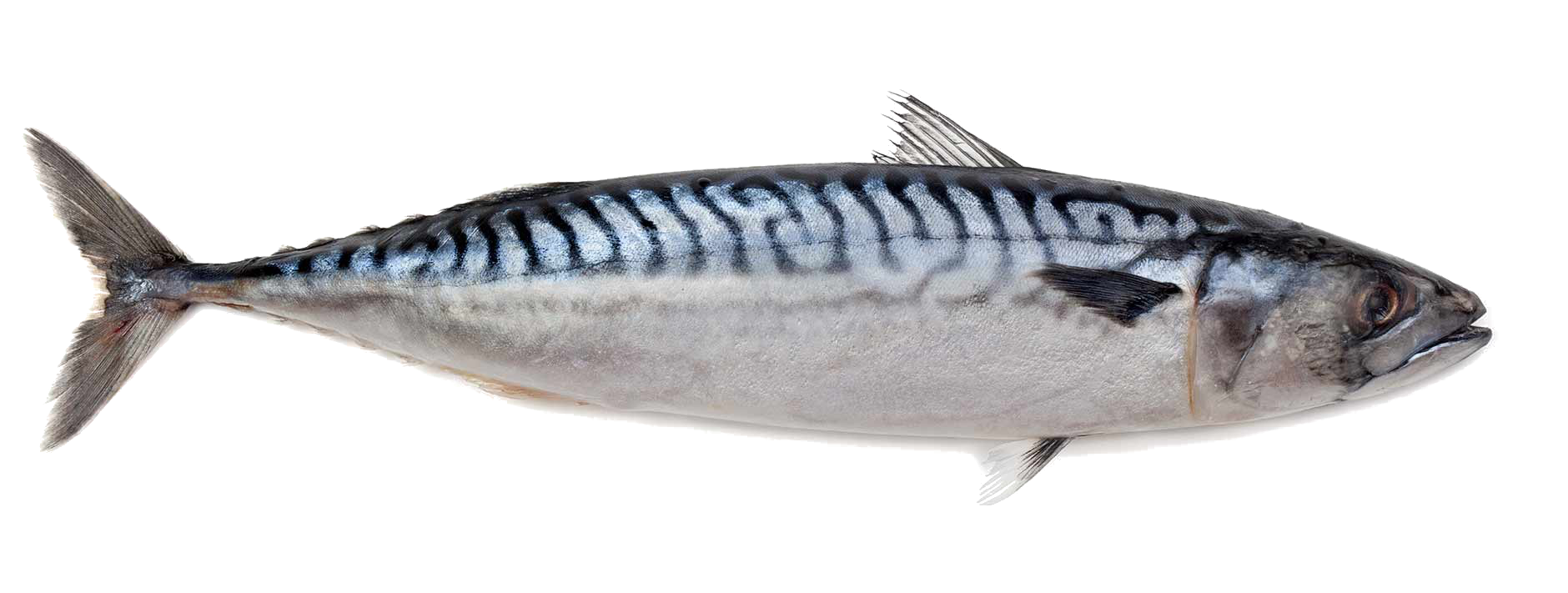
The Atlantic Mackerel (Scomber scombrus), is one of the healthiest seafoods on the planet. It’s a beautifully iridescent and athletic fish that goes by many names such as Boston mackerel, Norwegian mackerel, Scottish mackerel or simply mackerel, in Irish: Maicréal or Ronnach. Not to be confused with the Atlantic horse mackerel (Trachurus trachurus) or common scad.
The mackerel is a migratory pelagic species (usually found down to a depth of 200m) that is widely distributed across the north-eastern Atlantic shelf. Its streamlined body is designed for fast swimming and the constant motion is necessary to bring in enough oxygen for the fish to survive. The constant motion is also essential, because the Atlantic mackerel has no swim bladder unlike most of their relatives and sinks if it stops moving. S. scombrus is related to the tuna and designed to roam the seas searching for food.
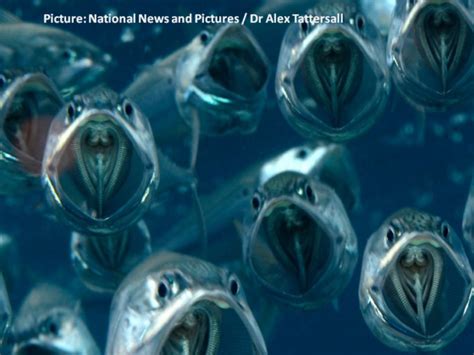
As tireless hunters and placed at trophic level 3.6, they feed at any depth from the seabed to the surface and depending on the season their diet consists of ragworms, juvenile fish, young squid and zooplankton. Their healthy lifestyle makes them a great source of nutrients (especially omega-3, protein, vitamin D and B12 & selenium) and an attractive diet for seabirds, seals and many predatory fish such as bass and pollack.
Juvenile mackerel grow rapidly and reach 30cm after just 2 years at which point more than half of them are mature. While the average age and size of caught mackerel is between 4 and 8 years and approximately 35cm, the species can live up to 17 years and reach 60cm in length. The maximum published weight of a single mackerel is 3.4kg.
Mackerel form dense shoals when migrating to spawning grounds. The dark wavy stripes on the upper part of their body are used as “shoaling marks”. By looking at the vertical lines on the neighbouring fish, each fish in the group can align itself with the rest of the shoal and adjust its swimming speed.
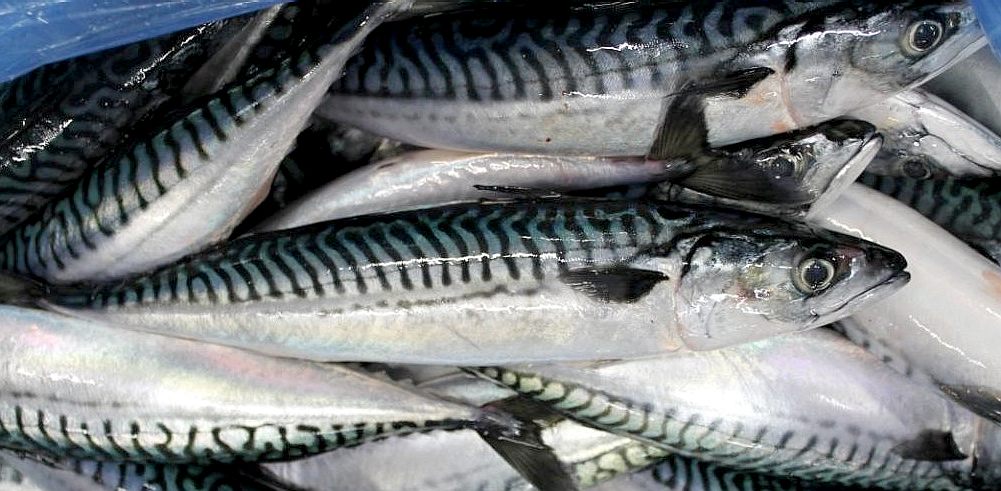
Spawning takes place between February and early July along the south and west of Ireland close to the shore. Reproductive females can produce as many as 450,000 eggs each. Eggs mature in batches over the course of a week and are pelagic once released, remaining within 15–25 m (49–82 ft) of the surface. Time to hatching is dependent on the water temperature, and ranges from 2 days in warm waters to 8.5 days in colder waters. Most eggs are spawned in a water temperature of 9–12 °C, and as such the majority of eggs hatch in about a week. Eggs are anywhere from 1.0–1.3 mm in size, becoming smaller towards the end of the spawning season.
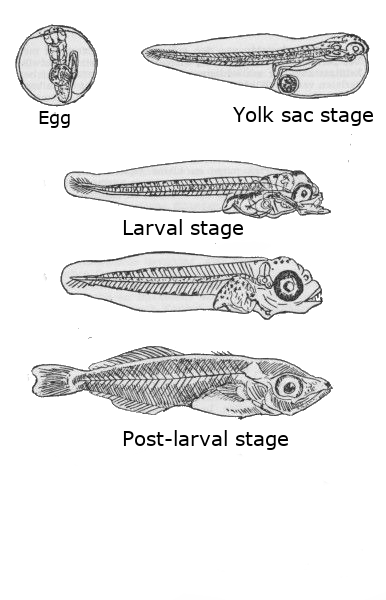
There are three larval stages: the yolk sac stage, the larval stage, and the post-larval stage. Larvae are 3 mm when they hatch and feed on the yolk sac for about 5 days. During the larval stage, which lasts about a month, larvae grow to 10 mm in length. At this point they are part of the zooplankton community floating with the currents rather than actively swimming as they still lack the power to do so. During the post-larval stage, which occurs over the next 40 days and during which the fish reaches 50 mm in length, it swims to the surface at night (to feed) and down to deeper waters during the day (to hide from predators). At the end of the post-larval stage, juveniles resemble an adult mackerel in all but size - this is when they start to shoal.
Food availability for the Atlantic mackerel increases greatly during the summer when zooplankton biomass is at its maximum, and the fish reach a peak for fat tissue in July/August feeding mainly on copepods (small crustaceans) with juvenile fish moving closer to the shore than adults. In the autumn and winter they move farther out and farther south to the warmer waters on the edge of the continental shelf. This movement starts in September and by December Atlantic mackerel are usually completely gone from the coasts.

